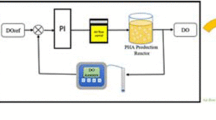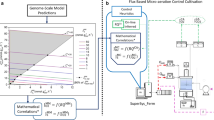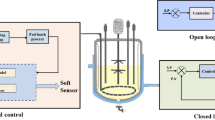Summary
This paper develops a practical and useful computer control scheme to control the specific growth rate as accurately as possible by measuring the released protons in anaerobic alcohol fermentation. In the case of current study, most of the released protons are due to the uptake of cationic ammonium ion via the conversion: NH4 + → NH3(cell) + H+. Correlating the Proton Production (PP) and the Proton Production Rate (PPR) with specific growth rate (μ) proved PP as a better measured variable. Using a simple adaptive control algorithm, μ was successfully controlled in a Zymomonas mobilis fed-batch culture.
Similar content being viewed by others
Reference
Uday Veeramallu and Pramod Agrawal (1988) Biotechnol. Bioeng. 31, 770–782
Pramod Agrawal and Henry C. Lim (1984) Biotechnol. Bioeng. 26, 1352–1363
Pramod Agrawal and Uday Veeramallu (1990) J. Chem. Tech. Biotechnol. 47, 1–14
Wen-Teng Wu, Kuo-Cheng Chen and Hung-Wen Chiou (1985) Biotechnol. Bioeng. 27, 756–760
Hiroshi Shimizu, Suteaki Shioya, Ken-ichi Suga and Takeichiro Takamatsu (1989) Appl. Microbiol. Biotechnol. 30, 276–282
Author information
Authors and Affiliations
Rights and permissions
About this article
Cite this article
Won, J.I., Yang, Y.L., Kim, B.G. et al. Adaptive control of specific growth rate based on proton production in anaerobic fed-batch culture. Biotechnol Lett 15, 511–516 (1993). https://doi.org/10.1007/BF00129328
Issue Date:
DOI: https://doi.org/10.1007/BF00129328




